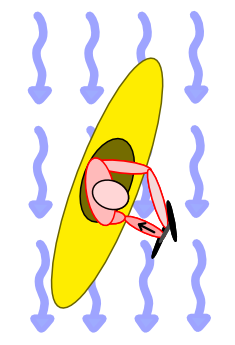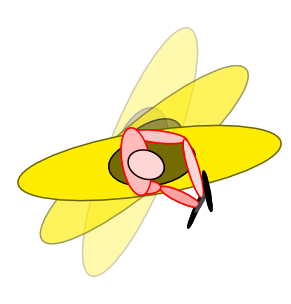
This stroke has been one of the most complicated maneuver to teach and to learn. The aim is to put order and, why not, physics, to understand what I call the draw stroke. I use basically only this stroke to change direction because is the most efficient way not to loose speed and to avoid the drifting effect.
For most kayakers this theory could sound quite different to what they learned in the kayak courses. I built up this theory to give a good explanation of what I really do in the river. I also tested this scheme to teach the "draw rudder" and seem to work with lots of people (class III paddlers).
Before to start
 In order to understand the draw rudder you have obviously to master the static rudder. The starting point is the central rudder, with the paddle vertical close to your body and the blade facing the kayak. The torso is rotated as much as possible toward the inside of the curve and the low arm is perpendicular with both paddle and kayak (see the figure). When I use the rudder I feel I have to hold the shaft in the direction of the arrow (centrifugal force). The static central rudder controls curves allowing the boat turning a bit and prevents the side drifting. This rudder is a good and effortless stroke when you need a curve with large radius of curvature (4-8 m).
In order to understand the draw rudder you have obviously to master the static rudder. The starting point is the central rudder, with the paddle vertical close to your body and the blade facing the kayak. The torso is rotated as much as possible toward the inside of the curve and the low arm is perpendicular with both paddle and kayak (see the figure). When I use the rudder I feel I have to hold the shaft in the direction of the arrow (centrifugal force). The static central rudder controls curves allowing the boat turning a bit and prevents the side drifting. This rudder is a good and effortless stroke when you need a curve with large radius of curvature (4-8 m).
The draw rudder
 However most of the time in the river I need to change direction quickly but without loss of speed and side drifting. This is exactly the aim of the draw rudder. While I'm doing a central rudder I rotate the kayak simply turning back my torso and moving the legs towards the direction where I want to go. The point of force application is the same I feel when I do the central rudder (indicated by the arrow).
However most of the time in the river I need to change direction quickly but without loss of speed and side drifting. This is exactly the aim of the draw rudder. While I'm doing a central rudder I rotate the kayak simply turning back my torso and moving the legs towards the direction where I want to go. The point of force application is the same I feel when I do the central rudder (indicated by the arrow).
Thus the paddle doesn't have to go towards the bow but it has to stay close to your body. The blade has also to keep sliding into the water like in the rudder. This point makes a big difference because, if the blade is sliding forward, the boat speed is maintained. The blade has to works as a wing.
This stroke can easily change the direction up to 90 degrees. It's important to note that for smaller angles the initial torso rotation has to be the same in order to put the paddle in the right place. In this case I just stop the rotation earlier with the shoulder not yet in line with the boat.
A common mistake is to have the blade facing forward. This will definitely turn the boat but you'll loose all the speed. If you do this stroke correctly you should even don't need a forward stroke after the turn because all the speed is maintained and the effect of the over-rotation after the curve tend to be null.
In order to make an efficient draw rudder you need to be able to also turn properly your torso (remember that the rotation comes from the back-rotation). This means that your body is completely rotated with your shoulder at almost 90 degree with the kayak. Looking to the inside of the curve could help to rotate the shoulder.


